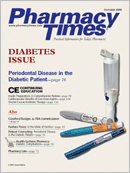Publication
Article
Pharmacy Times
Predicting Interactions with PDE5 Inhibitors
Author(s):
There are 3 phosphodiesterase type 5 (PDE5) inhibitors currently marketed for the treatment of erectile dysfunction: sildenafil (Viagra), tadalafil (Cialis), and vardenafil (Levitra). These products are well known for their potential pharmacodynamic interaction with vasodilators?particularly nitrates?resulting in excessive hypotension. All 3 are contraindicated for concomitant use with nitrates.1-3
The PDE5 compounds also are susceptible to pharmacokinetic interactions caused by drugs that induce or inhibit their metabolism. Although published data are limited, the PDE5 agents all appear to be primarily metabolized by cytochrome P-450 3A4. In addition, sildenafil and perhaps vardenafil are metabolized by CYP2C9, although to a minor extent.4 Furthermore, vardenafil metabolism has been reported to be mediated by CYP3A5, an enzyme closely related to CYP3A4.
Moreover, the PDE5 drugs differ in some of their pharmacokinetic parameters. Sildenafil and vardenafil have half-lives of 4 to 5 hours, whereas the half-life of tadalafil is ~17 hours. The bioavailability of sildenafil is reported to be 40%, and that of vardenafil is 15%; however, the bioavailability of tadalafil has not been reported.
As is often the case with newer drugs, pharmacists may have to evaluate potential drug interactions with the PDE5 drugs, or compare their potential to interact with various precipitant drugs, based on limited interaction data. Using what interaction data are available and the known properties of the object drugs can be helpful in assessing unreported, potential interactions.
The Table shows mean percentage changes in maximal concentrations (Cmax) and areas under the concentration time curve (AUC) for the PDE5 agents when coadministered with precipitant drugs (CYP3A4 inhibitors) that were studied in more than one PDE5.
The data in the Table also show that the only exactly comparable interaction study that has been done involves ketoconazole (200 mg/day) with tadalafil and vardenafil. The effect of ketoconazole on vardenafil appears to be greater than its effect on tadalafil. This finding may be due to the lower bioavailability of vardenafil, indicating extensive first-pass metabolism. If the bioavailability of tadalafil is similar to that of sildenafil, the difference in first-pass metabolism between the 2 PDE5 agents may partially account for the difference in the magnitude of the interaction. As would be expected, the larger dose of ketoconazole (400 mg/day) produced a greater effect on tadalafil than the 200-mg/day dose.
The effect of ritonavir on sildenafil's Cmax and AUC is less than that of a similar dose of ritonavir on vardenafil's parameters. These differences between sildenafil and vardenafil again may be partially explained by differences in first-pass metabolism.
Erythromycin also appears to produce a larger effect on vardenafil than on sildenafil. Yet, differences in inhibitor dose and lack of study details make comparisons more difficult.
Although data defining the magnitude of potential interactions with the PDE5 agents are quite limited, some general observations can be made. All 3 drugs should be used with caution in patients receiving any substance known to inhibit CYP3A4 (eg, amprenavir, ritonavir, indinavir, saquinavir, nelfinavir, clarithromycin, erythromycin, itraconazole, ketoconazole, fluconazole, voriconazole, diltiazem, verapamil, telithromycin, nefazodone, fluvoxamine, and grapefruit juice), because increased side effects may occur. Vardenafil appears to be more affected by CYP3A4 inhibitors, compared with sildenafil and tadalafil. This increased sensitivity may be due to its greater first-pass metabolism and lower bioavailability. Since more vardenafil normally is metabolized prior to reaching the systemic circulation, a greater increase in systemic exposure can occur when the first-pass metabolic pathways are inhibited by CYP3A4 inhibitors.
Pending the publication of further studies detailing interactions with PDE5 agents, pharmacists will have to use their knowledge of drug metabolism and drug interactions to infer the risk to their patients of potentially interacting drugs. Prescribers should be notified of these potential interactions and advised of alternative, noninteracting agents when available. Patients should be counseled to be alert for increased PDE5 side effects if they also are receiving CYP3A4 inhibitors.
Dr. Ta is a pharmacist with Bartell Drugs in Seattle, Wash. Drs. Horn and Hansten are both professors of pharmacy at the University of Washington School of Pharmacy. For an electronic version of this article, including references if any, visit www.hanstenandhorn.com.
For a list of references, send a stamped, self-addressed envelope to: References Department, Attn. A. Stahl, Pharmacy Times, 241 Forsgate Drive, Jamesburg, NJ 08831; or send an e-mail request to: [email protected].

Newsletter
Stay informed on drug updates, treatment guidelines, and pharmacy practice trends—subscribe to Pharmacy Times for weekly clinical insights.






